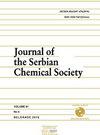垃圾填埋场可沉降粉尘中有毒元素的健康风险评估
IF 1
4区 化学
Q4 CHEMISTRY, MULTIDISCIPLINARY
引用次数: 0
摘要
2021年期间,从塞尔维亚的两个大型非卫生垃圾填埋场(Zrenjanin和Novi Sad)开展了四次可沉积粉尘监测活动。采用激光衍射和电感耦合等离子体-光学发射光谱(ICP-OES)分析了样品的粒径分布(PSD)和有毒元素(TEs)浓度。根据美国环境保护署(EPA)基于TEs浓度的方法对垃圾填埋场工作人员进行了健康风险评估。粒径分布结果表明,大部分可沉降尘样品质量既不集中在PM2.5范围内,也不集中在PM10范围内。分析显示,两个垃圾填埋场的TEs浓度都很高:在Zrenjanin垃圾填埋场的样品中检测到极高浓度的Cr和Zn。两个填埋场的元素健康风险潜势如下:Cr > Co > Pb > Ni > Zn > Cu。结果表明,Zrenjanin和Novi Sad的最大危害指数(HI)分别为1.97*10-1和1.13*10-1,非癌风险极低。对于这两个垃圾填埋场,CR的癌症风险(CR)最高(Zrenjanin为2.75*10-5,Novi Sad为2.02*10-7),尽管仍在规定的可耐受癌症风险阈值之内。本文章由计算机程序翻译,如有差异,请以英文原文为准。
Health risk assessment of toxic elements in sedimentable dust from landfills
Four monitoring campaigns of sedimentable dust were provided from two large non-sanitary landfills (Zrenjanin and Novi Sad) in Serbia during 2021. Particle size analysis by laser diffraction and inductively coupled plasma - optical emission spectrometry (ICP-OES) were carried out in order to obtain particle size distribution (PSD) and toxic elements (TEs) concentrations. The health risk assessment of the landfill employees was performed according to United States Environmental Protection Agency (US EPA) methods based on TEs concentrations. The particle size distribution results demonstrated that the majority of sedimentable dust samples mass were not concentrated neither within PM2.5 neither within PM10 fraction. Analysis revealed high concentration of TEs at both landfills: an extremely high concentration of Cr and Zn in samples from Zrenjanin landfill was detected. Health risk potential of elements was as follows for both landfills: Cr > Co > Pb > Ni > Zn > Cu. According to the results, maximal hazard index (HI) for landfill employees in Zrenjanin (1.97*10-1) and Novi Sad (1.13*10-1) showed that non-cancer risk was very low. For both landfill sites, cancer risk (CR) was highest for Cr (2.75*10-5 for Zrenjanin and 2.02*10-7 for Novi Sad), though still within the defined threshold for tolerable cancer risk.
求助全文
通过发布文献求助,成功后即可免费获取论文全文。
去求助
来源期刊
CiteScore
1.80
自引率
0.00%
发文量
76
审稿时长
1 months
期刊介绍:
The Journal of the Serbian Chemical Society -JSCS (formerly Glasnik Hemijskog društva Beograd) publishes articles original papers that have not been published previously, from the fields of fundamental and applied chemistry:
Theoretical Chemistry, Organic Chemistry, Biochemistry and Biotechnology, Food Chemistry, Technology and Engineering, Inorganic Chemistry, Polymers, Analytical Chemistry, Physical Chemistry, Spectroscopy, Electrochemistry, Thermodynamics, Chemical Engineering, Textile Engineering, Materials, Ceramics, Metallurgy, Geochemistry, Environmental Chemistry, History of and Education in Chemistry.

 求助内容:
求助内容: 应助结果提醒方式:
应助结果提醒方式:


